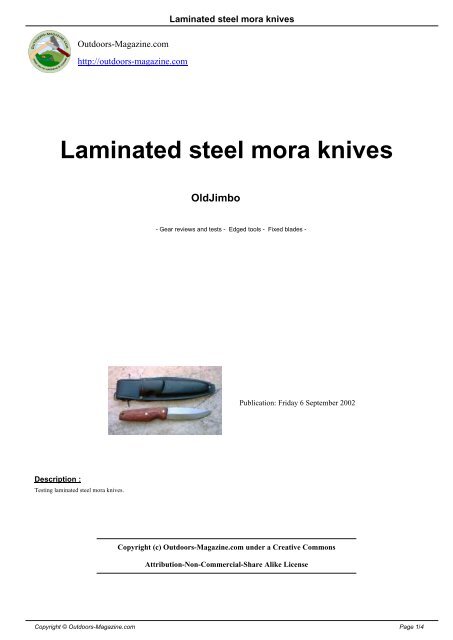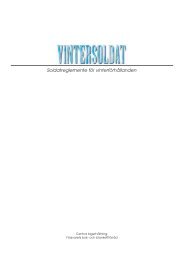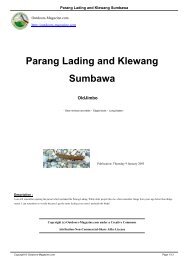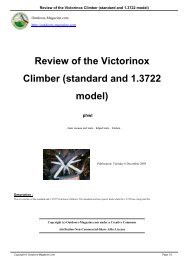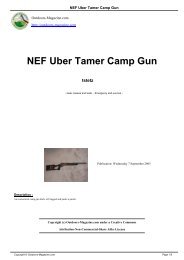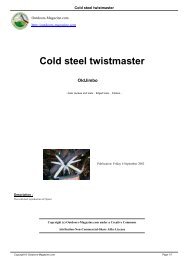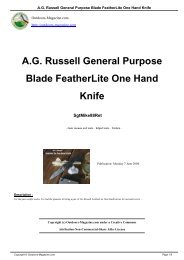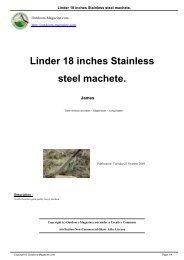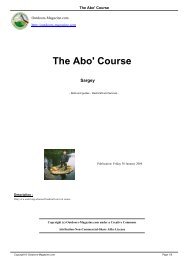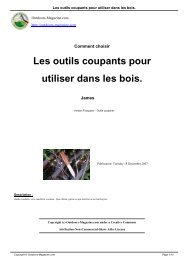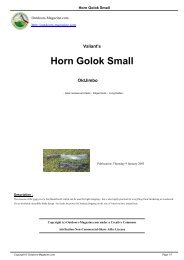Laminated steel mora knives - Old Jimbo's Site
Laminated steel mora knives - Old Jimbo's Site
Laminated steel mora knives - Old Jimbo's Site
You also want an ePaper? Increase the reach of your titles
YUMPU automatically turns print PDFs into web optimized ePapers that Google loves.
Description :<br />
Outdoors-Magazine.com<br />
http://outdoors-magazine.com<br />
<strong>Laminated</strong> <strong>steel</strong> <strong>mora</strong> <strong>knives</strong><br />
<strong>Laminated</strong> <strong>steel</strong> <strong>mora</strong> <strong>knives</strong><br />
Testing laminated <strong>steel</strong> <strong>mora</strong> <strong>knives</strong>.<br />
<strong>Old</strong>Jimbo<br />
- Gear reviews and tests - Edged tools - Fixed blades -<br />
Publication: Friday 6 September 2002<br />
Copyright (c) Outdoors-Magazine.com under a Creative Commons<br />
Attribution-Non-Commercial-Share Alike License<br />
Copyright © Outdoors-Magazine.com Page 1/4
<strong>Laminated</strong> <strong>steel</strong> <strong>mora</strong> <strong>knives</strong><br />
I've been a long time getting hold of some laminated <strong>steel</strong> Mora <strong>knives</strong>. This is surprising since I have a drawer full of<br />
the regular carbon <strong>steel</strong> variety and the laminated variety are available at a reasonable price from Lee Valley. So I<br />
decided to get one of each of the four varieties of laminated <strong>steel</strong> available - basically the same stuff in four blade<br />
lengths. Since the <strong>knives</strong> are still on their way it's a good time to go over the considerations..<br />
I'm a great fan of Moras of the regular carbon <strong>steel</strong> variety, and that's probably why I haven't been in a hurry. These<br />
are supposed to be of slightly softer <strong>steel</strong> at the edge - 59RC as opposed to 62RC - but certainly hard and tough<br />
enough. The edges have held so well that I haven't had an overwhelming desire to get something better. The <strong>steel</strong><br />
holds an edge through most of the rough wood whittling I do, and are quickly brought back to a razor edge at the end<br />
of the day by a little stropping. While lots of people tout the easy sharpening of the laminated Moras because of their<br />
soft <strong>steel</strong> cladding, I'm quite happy to put an initial edge on a knife with an hour's work with a diamond stone or a few<br />
minutes on a belt grinder. Then I strop on the razor edge and from then on I rarely ever touch the knife to a stone - I<br />
just strop for a few minutes after a day's use. Sometimes I polished up the bevel a bit with a fine diamond stone if it<br />
had gotten some rust spots from my careless use, but that was just to get it clean for stropping. Just a few minutes<br />
on a stone was all that was required - and then only because I left the knife in the truck after use when the wax from<br />
the honing compound had been worn off the blade. So all in all, the ease of sharpening has never been a<br />
consideration. Now that I've got a leather belt loaded with buffing compound for the grinder I find it a pity that Moras<br />
are so easy to sharpen. So all in all, I don't expect to be blown away by ease of sharpening.<br />
The laminated blades are supposed to be more tolerant of flexing, at the expense of having a hard enough back to<br />
strike flint. I did have some wonderful ideas of differentially tempering the blades of regular carbon <strong>steel</strong> Moras. This<br />
is a simple process with a pencil torch, but I never got around to it because I didn't get any <strong>knives</strong> breaking or such.<br />
After a while I did think that I'd prefer the back at full hardness for striking flint, and because I use a baton so much.<br />
I'm not so sure that the flint idea is so great, a piece of broken file being better. Now you can get a spark from a<br />
regular <strong>steel</strong> Mora - but without some char cloth or <strong>steel</strong> wool you're not likely to get a fire started when stuck with<br />
only your trusty Mora. If I needed a hard edge to scrape a ferrocerium rod and didn't have a piece of hacksaw blade,<br />
then I'd do what I do now and scrape with a sharp rock. Like most people I get all of these wonderful armchair ideas<br />
for improving stuff which upon reflection just aren't worth the trouble. So- - - I'm not expecting that the softer <strong>steel</strong><br />
side laminates will give any special advantage or even give any problems. I am interested to see if baton use will<br />
cause problems, but that's about it.<br />
I guess what I should really be anticipating is the superior edge holding of the blades. The fact is though, that having<br />
some M2 blades I doubt that I'm going to be blown away. The regular Mora carbon blades hold a sufficient edge<br />
between stroppings for me anyway. Chipping might well be an issue as when these <strong>knives</strong> are used in the bush you<br />
can't avoid coming across some tougher stuff than might be found in regular carving. I'm thinking of bone here, but<br />
there are many other abuses.<br />
I am sure though that the <strong>knives</strong> will have some advantage. These are mass production <strong>knives</strong> that have remained<br />
the same for many years, and every one has some good reason for its long term existence. That's part of the fun of<br />
<strong>knives</strong> for me, even though I'm limited to cheap ones: finding the special advantage. It'll probably be something as<br />
simple as having full size handles on small bladed wood carving <strong>knives</strong>...<br />
The Knives Arrive!<br />
I was certainly impressed with the <strong>knives</strong> on first inspection. The handles were plain birch, but at least they weren't<br />
painted! The blades were decently polished and coated in a very thin layer of varnish. I looked them over and could<br />
Copyright © Outdoors-Magazine.com Page 2/4
<strong>Laminated</strong> <strong>steel</strong> <strong>mora</strong> <strong>knives</strong><br />
find none of the polished over grind marks common to regular Moras. My first thought was that I'd been pretty dumb<br />
to encourage people to get regular Moras when these are available for just a few dollars extra.<br />
That didn't last too long! A few minutes rubbing the bevels on carborundum paper soon showed that the bevels<br />
weren't flat and that there still was a secondary bevel that had to be ground away. The smallest knife took over an<br />
hour with a diamond hone. I could have used the belt grinder but I wanted to see how long it would take. The other<br />
<strong>knives</strong> went far faster as the bevels weren't so bad - say 30 minutes per knife using 600 grit carborundum paper on a<br />
flat surface. As always it's a strange feeling to be scratching some polished blades, seeing flakes of metal come off<br />
the high spots as the edge gets straightened. Gradually though, everything looks better through the 16X lens and<br />
feels better and it's time for stropping. The scary edge comes up fast and pulling the edge through paper gradually<br />
shows few and fewer dull spots. I guess that the bottom line is that original grinding of the bevels varies and that a<br />
person is in for between 30 and 60 minutes to get a good durable edge. As good as the plain birch handles feel, I'll<br />
probably burn and sand anyway before treating with tung oil so nothing is saved there in terms of preparation time.<br />
My one big complaint with the <strong>knives</strong> would be with the sheaths. The 2" has the same sheath as the 4": I'd have<br />
thought that Frost would have at least have had a run of sheaths of various sizes - they must sell enough <strong>knives</strong> to<br />
make this worthwhile. The 2 3/4" also has what appears to be a new variety of sheath - same plastic just a grey color<br />
and with what appears to be a weaker integral belt loop. Anyway, it doesn't hold very firmly, and even appears as if it<br />
isn't the correct sheath for the knife. A little burning and scraping of the handle should at least make the fit in the<br />
sheath safer.<br />
So..<br />
You buy a set of cheap <strong>knives</strong>, spend a bunch of time sharpening them and end up with some decent woodworking<br />
tools. The <strong>knives</strong> are comfortable to use and take a very good edge with enough work. As is I can sure slice a pile of<br />
paper before re-stropping on a piece of cardboard with a little green honing compound - and it takes about one<br />
minute to bring back the edge. All the <strong>knives</strong> feel good to carve wood with, especially the slim bladed models with the<br />
oversized handles. I like them a lot and am going to order a bunch of the 3 1/8" as Lee Valley will no longer be<br />
carrying them. It's take a few months of whittling on wood to really test the <strong>steel</strong> - this involves a lot of hard prying<br />
which is more stressful to edges than just slicing paper. I expect good results since people have been using these on<br />
wood for a long time. So far things have worked out well. A big help to avoiding chipping might well be the polishing<br />
of the bevels.<br />
One of my friends was over and looked at the <strong>knives</strong>. He just recognized them as sloyd <strong>knives</strong> - and that says it all.<br />
Sloyd or slojd is just a method of working wood with simple hand tools - which was developed in Scandinavian<br />
countries. Stuff like using a hatchet to rough shape, draw and regular <strong>knives</strong> to shape what you want instead of using<br />
chisels and stuff. That pretty well says it all - shaping wood is a pretty important ability in the outdoors, and one might<br />
as well go with a proven method and tools. Not very glamorous and certainly not the stuff of dreams of fighting off big<br />
critters with huge <strong>knives</strong>. The <strong>knives</strong> themselves are best seen as tools and one shouldn't need any "out of box<br />
experience" when getting them. If a lot of work is needed to fix them up, then this is a vital skill to have, and gives<br />
one knowledge of <strong>knives</strong> and edges.<br />
A Couple of Months Later:<br />
I bought a couple of no-name Mora <strong>knives</strong> from Lee Valley to test against the laminated Frost versions. These must<br />
be collectors items with no maker's logo - and only $8.95 CAN! Anyway they have narrow blades and are advertised<br />
Copyright © Outdoors-Magazine.com Page 3/4
<strong>Laminated</strong> <strong>steel</strong> <strong>mora</strong> <strong>knives</strong><br />
as being carbon <strong>steel</strong> at RC57. Like the laminated types they've proven to be very useful, and if they're softer <strong>steel</strong><br />
than normal, I'm not seeing any real difference in practical use. They came with better sheath fit than the laminated<br />
versions, and actually a better bevel on the blade. My bet is that a lot of knife users would use them right away or<br />
with just a touch up sharpening and find that they held an edge longer than the laminated <strong>knives</strong>. With proper<br />
sharpening of both versions, though they won't. Lots of the cheaper Scandinavian <strong>knives</strong> used for carving such as<br />
the Lauri are only hardened to 57 with the philosophy that the ease of sharpening and increased toughness of the<br />
edge pays off. Other people don't want to stop even for a minute in the middle of carving to sharpen - and prefer a<br />
harder blade. For whittling in the bush where most of the woods are softer, I don't think that people will notice a lot of<br />
difference. I have tried the laminated blades with a baton on dry wood and haven't noticed any chipping of the edge<br />
yet. That might change with extensive trials.<br />
It's sure going to be a while until I've got around to doing all the nasty things I do with <strong>knives</strong> to check out the<br />
laminated blades. For the present time, the point to consider is the initial price of the <strong>knives</strong>, and the great designs.<br />
The slim bladed <strong>knives</strong> are perfect for the bush allowing heavy duty use with their larger handles - despite the slim<br />
blade profiles. The short wider blade is very useful, having a more substantial handle than the tiny red handled<br />
version. The 3 3/4" is of course a good regular belt or neck knife. I believe that the main point is that you sure can't<br />
argue with the price and weight. Just get one or more and test them for your purposes. These appear so far to me to<br />
be fine <strong>knives</strong> - but they are most certainly not the pinnacle of the Scandinavian knifemaking art. If you want<br />
something better then that something is readily available at Brisa, and Dennis Holmbacka is a great guy to advise<br />
you. These Moras will just be the starting point for some. For others like me then they may be the main knife for<br />
many years to come as I'm satisfied.<br />
For now I'll finish up with my favourite knife hype from the movie "Exposure" starring Peter Coyote. As the knife<br />
dealer says, "This is a......., treacherous, fierce <strong>steel</strong>. Honed on natural stones by hand, by masters." If you dispense<br />
with the fierceness and the treachery, become a master sharpener by practise, and use some cheap sharpening<br />
tools, you can have a super knife with a Mora. I really don't believe that's hype. Whether or not you find the laminated<br />
blades to be superior is going to depend a lot on how you use them, but I do believe that if you give the slim blade<br />
profiles a chance you might find them to be just what you need.<br />
Post-scriptum :Original article at <strong>Old</strong><strong>Jimbo's</strong> site.<br />
Copyright © Outdoors-Magazine.com Page 4/4


